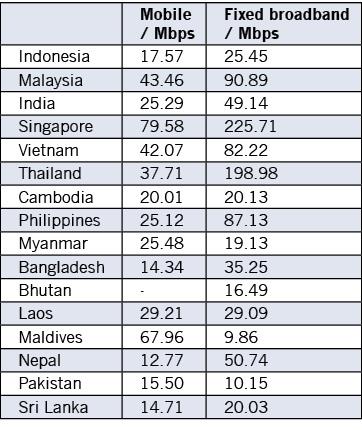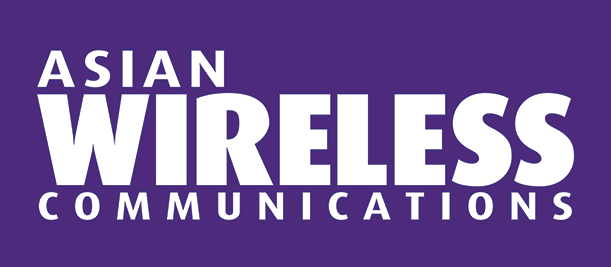05 April 2023
Broadband availability has a huge impact on the development of a nation; however, access varies widely across southern Asian countries. Amy Saunders asks those in the know to expand on the reasons why
Southeast Asia is home to a vibrant digital economy - expected to expand from US$194 million in 2022 to US$330 million by 2025 (Statista) - with more than 400 million internet users, and a high average internet penetration rate of around 70%.
Much of southern Asia benefits from broadband-speed connectivity via either fixed or mobile. Singapore is world-leading for average fixed broadband speeds of 225.71Mbps as of December 2022, combined with an impressive 79.58Mbps for mobile, and an internet penetration rate of 92%. In contrast, Cambodia, Bhutan, Pakistan, and Sri Lanka languish at the bottom of the table for speeds.
Expanding broadband
Typified by a wide variety of natural landscapes and island topology, one of the primary roadblocks on the way to regionwide broadband availability is infrastructure.
“Poor road conditions or non-available land routes create a barrier of entry for the service provider, and the lack of sufficient and reliable power supply compounds this issue. The investments required to improve this are very high – and economic challenges, especially post-COVID, impair the extent that the government can help,” says Ganendra Selvaraj, chief commercial officer, MEASAT.
Hagai Offeck, senior director of presales engineering, Parallel Wireless, concurs: “the absence of basic foundations - power sources and roads allowing access with building materials for the construction of sites - makes the deployment of broadband solutions both challenging and expensive.”
Building a cellular site in a rural area is extremely expensive with “the network design, laying the roads, building the towers in deserted areas, providing the necessary power source (solar/generator), added to challenging transmission and the operational burden and costs,” asserts Offeck.
Another barrier is that the population in today’s remaining unconnected areas typically live in low density environments with houses and communities sparsely distributed. “In these non-service areas there is usually a low count of inhabitants, and the citizens in those areas are usually quite poor; in the best scenario, they own legacy handsets for voice and texting,” says Offeck. “The ROI for any such an investment is low to non-existent which deter potential investors, and the governments in those areas are usually too poor to allocate the needed budgets.”
Selvaraj notes that economies of scale should be considered: “unlike urban locations which have the benefit of higher ARPU users and denser population distribution that provide better return of investment, rural communities typically have lower spending power, and due to the sparse population distribution, requires a distributed network.”
Satellite networks are ideal for these areas, says Selvaraj, “but having multiple service providers may not be ideal as scale cannot be achieved and costs will remain high. Consolidating the network within one or a small number of providers who work closely with the government can help make this more cost effective. In Malaysia, private service providers like MEASAT are collaborating with the government to support the national goal of having full internet coverage in populated areas, even in areas without terrestrial connections.”
Change from the top down is necessary to continue to drive the rollout of broadband across the entirety of southern Asia. To achieve this, regulators and policy makers must make the right decisions to increase coverage, improve quality, and drive affordability.
“Universal Service Obligation projects which specifically focus on building out infrastructure in areas which lack commercial value, and government support in terms of direct subsidy, especially for lower income groups, will help accelerate broadband rollout targets,” says Selvaraj.
Offeck asserts that policies that can address the barriers include international funding; laws to enforce complete deployments in rural areas; allowing sharing between operators on non-profitable investments which will provide coverage to rural areas; initiating RFI/ RFPs with some regulation/ governmental benefits to gather information and proposals from investors; and the removal of governmental boundaries like spectrum pricing, taxes and regulatory charges, and subsidising handsets.
“By changing regulations and enforcing deployments, allowing the operators to share non-profitable investments in these rural areas, private investors will be encouraged to invest in these projects,” states Offeck.
Moving on up

Median download speeds as per Ookla’s December 2022 Speedtest Global Index
Advancement in connectivity rates and technologies are on a one-way march – onwards and upwards.
“I am confident that we will see an improvement in both the quality of service and overall coverage. The extent and speed of growth will depend on the coordinated efforts of the government and local private sector providers,” says Selvaraj.
Asia Pacific nations are already dominated by 4G when it comes to mobile connectivity. With the demand for higher speeds and lower latency born of the increased remote workforce, 5G adoption rates are expected to accelerate; by 2025, the GSMA estimates more than 400 million 5G connections in the region, accounting for 14% of mobile connections.
Offeck, too, believes that “in five years, at least 40% of southern Asia’s traffic will require wide broadband availability due to the adoption of 5G technology by most users.”
One area of concern for southern Asia is the gender gap. Highlighted by the GSMA, the mobile internet gender gap grew from 36% in 2020 to 41% in 2022, due to increased mobile internet adoption by men, but stalling rates among women.
Further innovation is required to raise internet usage rates among women for the creation of a more inclusive and wealthy digital society for the benefit of each individual and the region as a whole.






